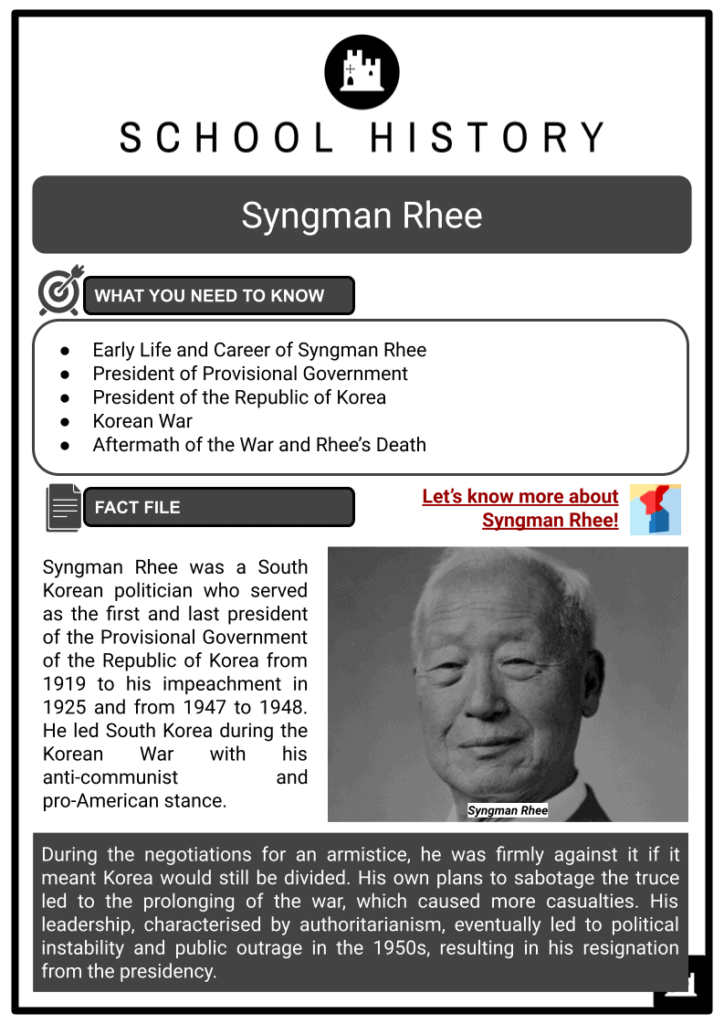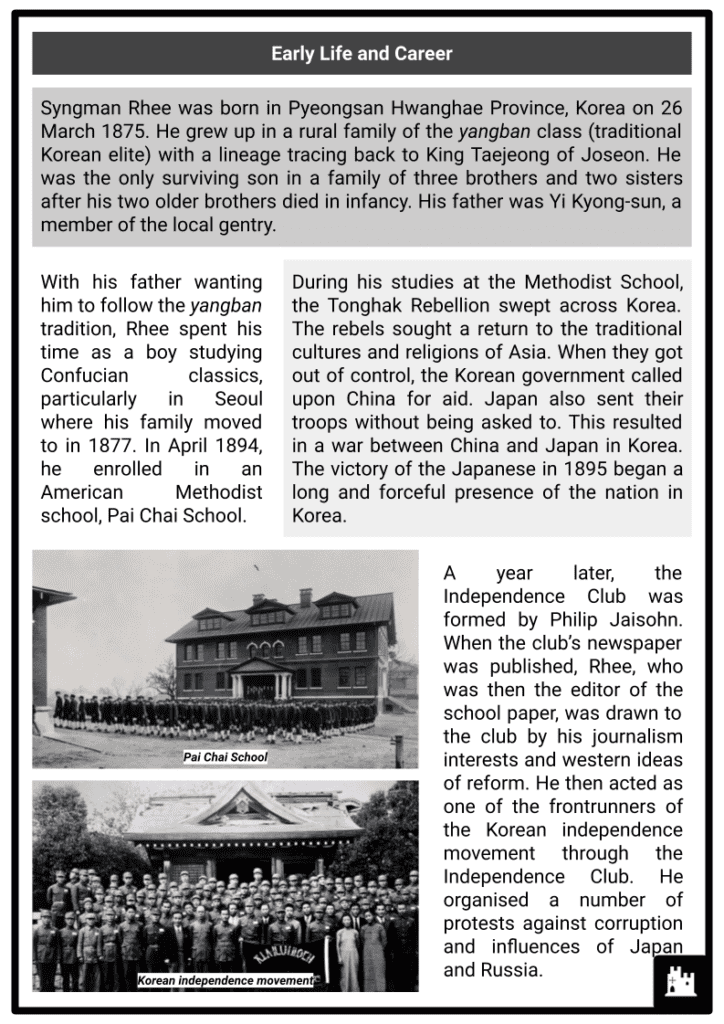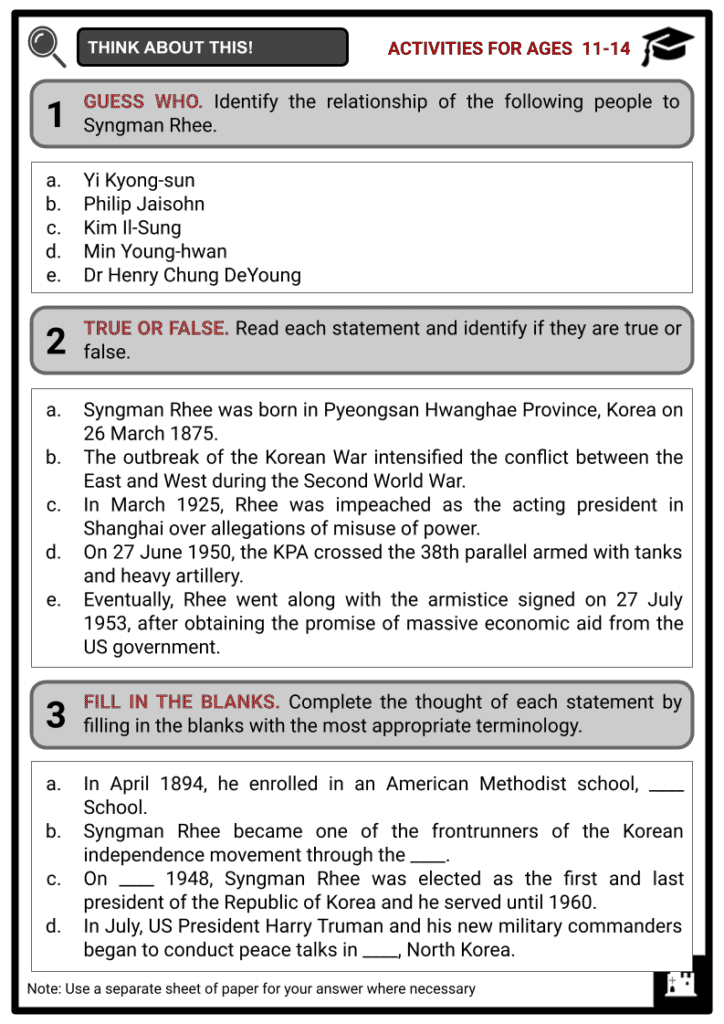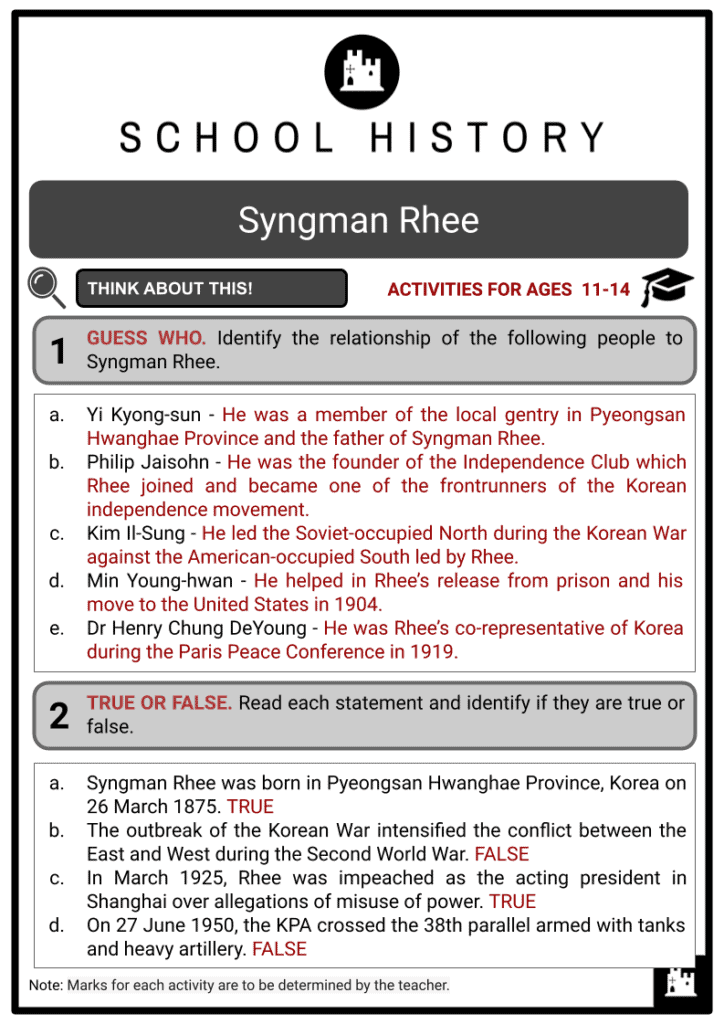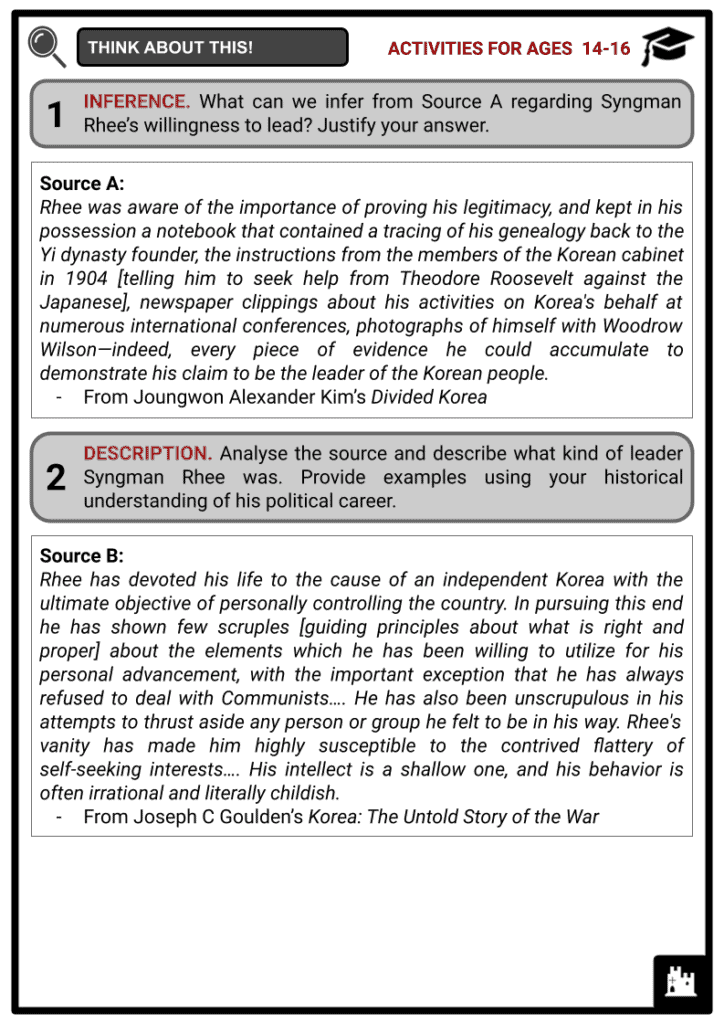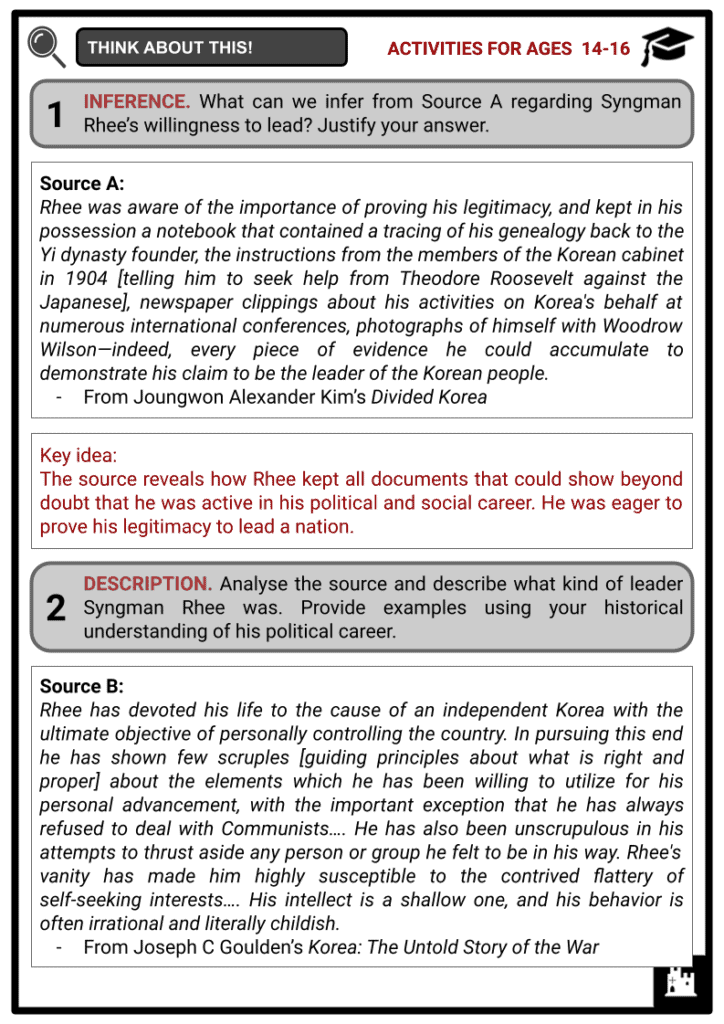Syngman Rhee Worksheets
Do you want to save dozens of hours in time? Get your evenings and weekends back? Be able to teach about Syngman Rhee to your students?
Our worksheet bundle includes a fact file and printable worksheets and student activities. Perfect for both the classroom and homeschooling!
Summary
- Early Life and Career of Syngman Rhee
- President of Provisional Government
- President of the Republic of Korea
- Korean War
- Aftermath of the War and Rhee’s Death
Key Facts And Information
Let’s find out more about Syngman Rhee!
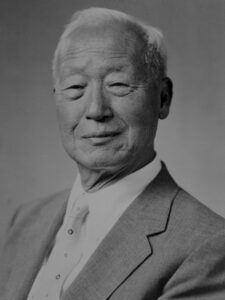
Syngman Rhee was a South Korean politician who served as the first and last president of the Provisional Government of the Republic of Korea from 1919 to his impeachment in 1925 and from 1947 to 1948. He led South Korea during the Korean War with his anti-communist and pro-American stance. During the negotiations for an armistice, he was firmly against it if it meant Korea would still be divided. His own plans to sabotage the truce led to the prolonging of the war, which caused more casualties. His leadership, characterised by authoritarianism, eventually led to political instability and public outrage in the 1950s, resulting in his resignation from the presidency.
Early Life and Career
- Syngman Rhee was born in Pyeongsan Hwanghae Province, Korea on 26 March 1875. He grew up in a rural family of the yangban class (traditional Korean elite) with a lineage tracing back to King Taejeong of Joseon. He was the only surviving son in a family of three brothers and two sisters after his two older brothers died in infancy. His father was Yi Kyong-sun, a member of the local gentry.
- With his father wanting him to follow the yangban tradition, Rhee spent his time as a boy studying Confucian classics, particularly in Seoul where his family moved to in 1877. In April 1894, he enrolled in an American Methodist school, Pai Chai School.
- During his studies at the Methodist School, the Tonghak Rebellion swept across Korea. The rebels sought a return to the traditional cultures and religions of Asia. When they got out of control, the Korean government called upon China for aid. Japan also sent their troops without being asked to. This resulted in a war between China and Japan in Korea. The victory of the Japanese in 1895 began a long and forceful presence of the nation in Korea.
- A year later, the Independence Club was formed by Philip Jaisohn. When the club’s newspaper was published, Rhee, who was then the editor of the school paper, was drawn to the club by his journalism interests and western ideas of reform. He then acted as one of the frontrunners of the Korean independence movement through the Independence Club. He organised a number of protests against corruption and influences of Japan and Russia.
- Due to his activism in the Independence Club, Rhee was arrested in 1898. When he attempted to escape during his 20th day in prison, he was caught and sentenced to life imprisonment in Hanseong Prison. However, at the outbreak of the Russo-Japanese War in 1904, Rhee was released from prison and moved to the United States with the help of Min Young-hwan and Han Gyu-seol.
- While in the United States, Rhee met with the Secretary of State John Hay and US President Theodore Roosevelt in August 1905 at the peace talks in Portsmouth, New Hampshire. He attempted, although unsuccessfully, to convince the US to help preserve independence for Korea. By the time he got to see Roosevelt, the United States had already agreed to recognise Japan’s interests in Korea. After his visit, Japan declared Korea a ‘protectorate’ and within five years, it annexed Korea, making it part of its expanding empire.
- Still in the US, Rhee made significant educational achievements:
- 1907 - Obtained a Bachelor of Arts from George Washington University
- 1908 - Obtained a Master of Arts from Harvard University
- 1910 - Obtained a PhD from Princeton University with the thesis ‘Neutrality as influenced by the United States’
- In 1910, Rhee returned to the Japanese-occupied Korea serving as a Young Men’s Christian Association (YMCA) coordinator and missionary. When he moved to Honolulu, Hawaii in 1913, he took over the Han-in Jung-ang Academy. He also established the Han-in Christian Church in 1918.
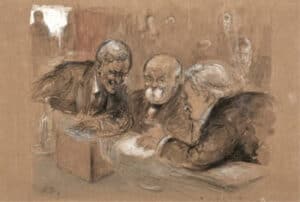
Paris Peace Conference 1919 - During the Paris Peace Conference in 1919 by the Korean National Association, Rhee was chosen as a Korean representative together with Dr Henry Chung DeYoung. He held the First Korean Congress in Philadelphia with Seo Jae-pil to make plans concerning Korean independence.
President of Provisional Government
- The outbreak of the Korean War intensified the conflict between the East and West during the Cold War. Korea became a Chinese tributary until the Sino-Japanese War in 1894–1895, during which it fell under the rival influences of Japan and Imperial Russia. In 1897, Emperor Gojong proclaimed the short-lived Korean Empire, which lasted until 1910.
- The Russo-Japanese War began in 1904 and ended in 1905 in favour of the Japanese empire. In the same year, they made Korea their protectorate and by 1910, annexed its dominion over Korea through a treaty. It remained part of the empire until 1945.
- After the Japanese annexation, several Korean nationalists fled the country whereby some sought refuge in nationalist China. On 1 March 1919, a declaration of independence was signed by leading Koreans and a huge Korea-wide demonstration known as the March First Movement swept across the country. The Japanese reacted harshly, resulting in thousands of deaths, injuries and arrests.
- In April 1919, still stirred by the March First Movement, a group of independence leaders formed the Korean Provisional Government naming Syngman Rhee as its first president. From December 1920 to May 1922, after the government was moved to Shanghai, Rhee became the acting president, yet failed to efficiently act on the role due to the conflicts inside the government.
- In March 1925, Rhee was impeached as the acting president in Shanghai over allegations of misuse of power. Despite being removed from office, he continued to claim the position by referring to the Hanseong Provisional Government and continued independence activities through the Korean Commission to America and Europe.
- The attack on Pearl Harbor and the Pacific War led Rhee to use his position as the chairman of the foreign relations department of the provisional government in Chongqing to convince the then US President Franklin Roosevelt to approve the existence of the Korean provisional government. He cooperated with anti-Japan strategies as part of his plan.
- When the Second World War came to an end in 1945, the Koreans were overjoyed with the prospect of liberation. This happiness was short-lived, however, since both the United States and the Soviet Union weren’t willing to let the other take control of Korea.
- At the time of liberation, Rhee was given a hero’s reception by the American Military Government, which was leading the southern half of Korea. Since then, his name was known in the country as a nationalist hero from the Independence Movement.
President of the Republic of Korea
- At first, the United States opposed the idea of establishing separate governments in Korea into the Soviet-occupied North and the American-occupied South. But they were also unwilling to withdraw from Korea to leave the Koreans to choose their government.
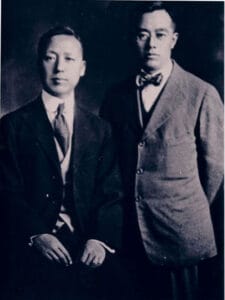
Rhee and Vice President of the Korean Provisional Government - In early 1948, the United Nations agreed to sponsor elections for Korea to become independent. However, the Soviets believed that the UN did not have the authority to do so and would not allow its representatives into North Korea to supervise the elections. So, in the end, the US supported elections in the south alone.
- On 20 July 1948, Syngman Rhee was elected as the first and last president of the Republic of Korea and he served until 1960. The North Koreans soon held their own elections and established the Democratic People’s Republic of Korea with Kim Il-Sung as the president. Rhee’s and Kim’s administrations led South Korea and North Korea, respectively, during the Korean War.
Korean War
- Kim Il-Sung believed that the South Korean Army was weaker than the Korean People’s Army (KPA). Hence, by March 1949, he sought the approval of Joseph Stalin to invade South Korea. Initially, Stalin did not approve this suggestion, but by April 1950, he confirmed that an invasion could take place on the condition that China would eventually assist the North Koreans. On 25 June 1950, the KPA crossed the 38th parallel armed with tanks and heavy artillery.
- By 27 June, Syngman Rhee had fled from Seoul. He spent the early days of the war fleeing from the North Koreans from one position to the next. Despite Rhee putting his South Korean troops under UN command, he was quick to threaten to pull them out if he disagreed with the Americans.
- With Rhee never allowing any opposition to his rule, he gradually lost support in his country. It was now obvious that he would lose the election for his second term if it were carried out as the constitution directed. Therefore, he placed the area of Pusan under martial law in May 1952 and arrested some members of the National Assembly. The assembly was forced to change the constitution and Rhee was elected for a second term.
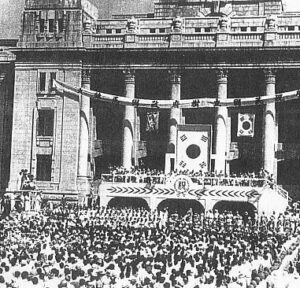
Ceremony inaugurating the government of the Republic of Korea - In June 1951, additional UN troops were deployed to Korea. Eventually, the communists were driven back above the 38th parallel. At this point, the war became a stalemate. In July, US President Harry Truman and his new military commanders began to conduct peace talks in Panmunjom, North Korea.
- While the armistice was being negotiated, Rhee was firm that he would never go along with a truce if it meant that Korea was still divided and there were still Chinese troops in the North. He then started to make his own plans to sabotage the truce, which led to damaging relations at the negotiating table, further prolonging the war.
- Pressured by assessments from right-wing Republican congressmen and high-ranking ROK generals and lured by Eisenhower’s offers, Rhee went along with the armistice signed on 27 July 1953, after obtaining the promise of massive economic aid from the US government. Despite how the millions of dollars obtained from the US helped Korea, Rhee’s actions prolonged the war, resulting in an estimated five million casualties. Around 50% were civilians, which is comparatively higher than the Second World War and the Vietnam War.
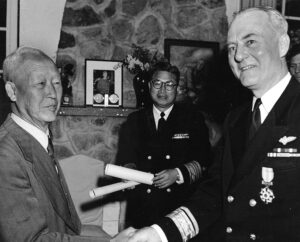
Rhee awarding a medal to US Navy Rear Ofstie during the Korean War
Aftermath of the War and Rhee’s Death
- As Syngman Rhee grew old, he became less able to work and compromise with others. Nonetheless, he was determined to keep his position and power even if it meant rigging the elections or intimidating his opponents.
- In April 1960, massive student protests erupted in South Korea. Despite his stubbornness, an ageing Rhee could no longer fight and so he was forced to resign the presidency. After his resignation, he quickly left the country for exile in Hawaii where he stayed until his death in 1965 at the age of 90.
Image Sources
- https://upload.wikimedia.org/wikipedia/commons/thumb/4/46/Rhee_Syng-Man_in_1948.jpg/800px-Rhee_Syng-Man_in_1948.jpg
- https://upload.wikimedia.org/wikipedia/commons/4/40/Paris_Peace_Conference.jpg
- https://upload.wikimedia.org/wikipedia/commons/2/22/RheeKim.jpg
- https://upload.wikimedia.org/wikipedia/commons/a/a6/Ceremony_inaugurating_the_government_of_the_Republic_of_Korea.JPG
- https://upload.wikimedia.org/wikipedia/commons/f/f6/Syngman_Rhee.jpg

